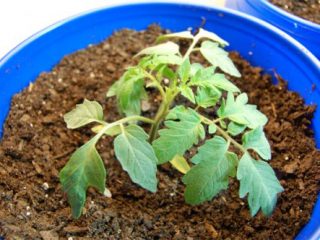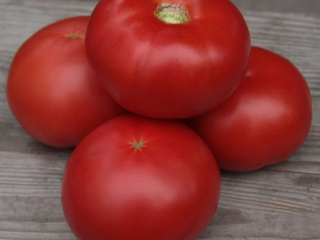Content
The Sweet Miracle tomato is a mid-season determinate variety of universal use, grown in unprotected soil. It is distinguished by good yield, resistance to major “tomato” diseases and a delicious, balanced taste of large flat-round fruits.
Breeding history
There is no detailed information about the origin of the Sweet Miracle tomato in available sources. It is only known that the variety was bred by Russian breeders.
Description and characteristics of the variety Sweet Miracle
The plant is a spreading, medium-sized bush of determinate type. Its strong stems stretch up to 70-80 cm when grown in open ground and up to 1.8 m when planted in a greenhouse. They are moderately branched and sparsely covered with medium-sized green leaves.

With proper agricultural technology, the weight of the Sweet Miracle tomato can reach 500 g
At the fruiting stage, multiple large tomatoes appear on the bush, collected in clusters of three and weighing on average 200-250 g.They have a flat-round, slightly ribbed shape and are covered with a thin but dense skin, colored red.
Ripening time
The Sweet Miracle tomato is considered a mid-season variety. Tomatoes ripen in 110-120 days from the moment of mass emergence.
Tomato yield Sweet miracle
The variety belongs to the group of highly productive ones. When growing in unprotected soil, I collect up to 10 kg of ripe tomatoes from each bush.
Resistance to adverse factors
The variety is characterized by good immunity. It is resistant to major tomato diseases and pests.
In what regions is it grown?
The Sweet Miracle tomato is successfully grown throughout almost the entire territory of the Russian Federation. In regions with warm climates it is planted in open ground. In the northern regions, the Sweet Miracle tomato variety is grown in greenhouses.
Methods of application
Fleshy, sugar-cooked tomatoes have a sweet, well-balanced taste and pleasant aroma. Although the variety is positioned as a salad variety, it is widely used in cooking. Sweet Miracle tomatoes are used to make juices, pastes, and dressings for soups and main courses. They are actively used in dietary and baby food.

The sweetness of tomatoes depends on the climatic conditions in the growing region: the more sun, the sweeter the fruits
Advantages and disadvantages
The Sweet Miracle tomato is a large-fruited, productive variety that is resistant to unfavorable growing conditions. It is valued for its excellent delicious taste and high sugar content.

The Sweet Miracle variety tolerates transportation well and ripens quickly at room temperature.
Pros:
- versatility;
- large fruit;
- strong immunity;
- transportability;
- high productivity;
- excellent taste.
Minuses:
- need for support.
Landing dates and rules
To ensure that tomatoes of this variety have time to ripen, they are grown by seedlings. Tomato seeds are sown from February to the first ten days of April. To do this, use suitable plastic or wooden boxes filled with a moistened purchased substrate or a mixture of turf soil, sand and peat. Before starting work, the seed is soaked for half an hour in a pale pink solution of potassium permanganate (10 g/l of water), washed and kept in a growth stimulator for at least 30-40 minutes. The prepared seeds are evenly distributed over the surface of the substrate, sprinkled with a layer of soil no more than 10 mm thick and covered with a transparent film to create a greenhouse effect.
After the first shoots appear, the containers are freed from the film cover and transferred to a cooler room. When 3-4 true leaves are formed on the plants, they are picked. The seedlings are watered as the soil dries and are hardened off two weeks before being transferred to the beds.

Tomato seedlings Sweet Miracle are placed according to a 50x30 cm pattern at the rate of three bushes per 1 m2
Transplantation is carried out approximately 60-65 days after sowing the seeds, when the likelihood of frost returning has disappeared. In an open, well-lit area with loose, fertile soil, shallow holes are dug. The plants are carefully removed from the cups, trying not to disturb the integrity of the earthen clod, placed in prepared holes and buried.The soil in the tree trunk circle is loosely compacted and watered abundantly with cool, settled water.
Care instructions
Although tomatoes of this variety are undemanding in care, neglecting standard agrotechnical manipulations can result in a decrease in yield. For rapid growth and proper development, they will have to ensure:
- Watering. During dry periods, the soil under the tomato bushes is moistened every other day. Under normal conditions, this is done 1-2 times a week. After flowering begins, watering is reduced, since excess moisture can lead to cracking of the fruit. The stream is directed closer to the roots, and to prevent water from spreading, it is poured into depressions or grooves.
- Feeding. Like other tall varieties, the Sweet Miracle tomato requires a large amount of nutrients. Therefore, mineral compounds are added to the tomatoes several times a season. Fertilizers containing phosphorus, potassium, nitrogen and magnesium are used in the early stages, before the formation of ovaries. Later, the soil under the bushes is sprinkled with wood ash.
- Land cultivation. The soil under the tomatoes is regularly loosened to improve water and air exchange and prevent moisture stagnation, which provokes the development of fungal infections. Also, the tree trunk circle and row spacing are weeded to remove weeds that steal water and nutrients from the crop.
- Formation of bushes. Plants form 1-2 stems, regularly tearing off wilted leaves, dried and excess shoots. The elongated stems are tied to a trellis with synthetic material, twisting them under each internode. Twice a month, tomatoes are pruned, getting rid of the shoots growing from the axils of the leaves.
- Hilling. Tomatoes develop additional roots that need to be covered with soil.Bushes are earthed twice per season: when root buds form on the shoots near the surface of the soil and when the lower part of the stem turns slightly blue. This will help protect the roots and retain moisture.
Disease and pest control
The Sweet Miracle tomato is immune to most common diseases. But with improper watering, lack of formation and pinching, the plant becomes susceptible to late blight. At the first signs of the disease and a small affected area, the plantings are treated with copper sulfate. In case of extensive damage, diseased plants are destroyed so that the infection does not spread to healthy bushes.

Copper sulfate is a copper-containing contact action fungicide.
Conclusion
The Sweet Miracle tomato is a popular mid-season variety of Russian selection that produces large, sweet tomatoes with a high sugar content. It is resistant to a whole range of serious diseases and is suitable for dietary and baby food.
Reviews from gardeners about the Sweet Miracle tomato








